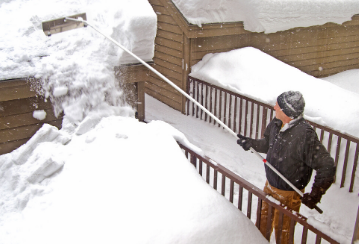Snow storm in the forecast? Protect your roof from a heavy snow load

For outdoor winter enthusiasts, a snow storm can mean great conditions for skiing, snowboarding, snowmobiling or epic snowball fights. However, a big storm can also dump a heavy load of snow on your roof and put it at risk for developing leaks, or even collapsing. Read on to find out how you can protect your roof and prevent damage from snow this winter.
How much snow can your roof handle?
Whenever a building is constructed, it must meet the standards of Ontario’s building code. The code determines the snow and rain load the roof must be designed to support based on several factors such as climate in your location and the slope and size of your roof. All roofs must support a minimum of 1 kilo Pascal (twenty-one pounds per square foot).
Code requirements and roof design methods have changed over time, as have the construction materials used. Roof trusses have been popular for several decades due to ease of construction and flexibility in design, while older roofs were typically hand-framed with rafters. That’s not to say that having a forty-year-old roof is cause for concern; in fact, it has demonstrated its viability over forty winters.
Be mindful of the following warning signs that could signal your roof is at risk:
-
The ceiling has sagged
-
Cracks appear in ceilings and/or interior walls
-
The roof leaks
-
Unusual cracking or popping sounds are audible
-
Doors and/or windows won’t close properly or are hard to open
-
Utility pipes are bent or warped
Does your home insurance policy cover collapses from snow load?
Most homeowner’s policies cover damage by roof collapse due to snow load; however, your insurer will need to examine any extenuating circumstances to determine eligibility. A claim for snow load damage should be reported to the insurer immediately so that an appropriate investigation can take place.
How can you help prevent roof collapse?
-
Perform regular maintenance: Ensure necessary repairs are done to keep it in good condition.
-
Use binoculars: Binoculars are useful to see your roof’s condition without having to climb on your roof.
-
Hire a professional snow removal company: It is always recommended to take steps to mitigate the chance of a roof collapse by contacting a contractor to properly remove snow and prevent further damage or risk injury. Under no circumstances should you attempt to remove the snow yourself, at the risk of personal injury.
-
Clean your roof often: It’s a good idea to clear your roof after every 15 cm of snowfall. This will prevent too much snow from accumulating and prevent ice dams, ridges of ice that form at the edge of your roof and prevent melting snow from draining properly.
-
Keep drains clear: Keep roof drains, gutters and downspouts clear and unblocked. Avoid piling snow against downspouts.
-
Take preventative measures: Consider preventing snow build-up by installing radiant heat that keeps your roof temperature above freezing or an ice barrier that prevents snow from sticking on metal roofs.
Questions about what is covered under your OTIP policy or need a quote? Contact an OTIP insurance broker today at 1-833-615-9326 to discuss your coverage needs.